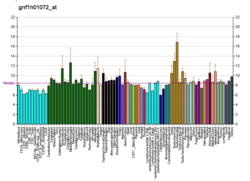| EAF1 |
|---|
|
| Identifiers |
|---|
| Aliases | EAF1, ELL associated factor 1 |
|---|
| External IDs | OMIM: 608315; MGI: 1921677; HomoloGene: 12561; GeneCards: EAF1; OMA:EAF1 - orthologs |
|---|
| Gene location (Human) |
|---|
 | | Chr. | Chromosome 3 (human)[1] |
|---|
| | Band | 3p25.1 | Start | 15,427,598 bp[1] |
|---|
| End | 15,450,635 bp[1] |
|---|
|
| Gene location (Mouse) |
|---|
 | | Chr. | Chromosome 14 (mouse)[2] |
|---|
| | Band | 14|14 B | Start | 31,216,356 bp[2] |
|---|
| End | 31,231,815 bp[2] |
|---|
|
| RNA expression pattern |
|---|
| Bgee | | Human | Mouse (ortholog) |
|---|
| Top expressed in | - amniotic fluid
- islet of Langerhans
- decidua
- monocyte
- secondary oocyte
- lower lobe of lung
- palpebral conjunctiva
- pancreatic epithelial cell
- epithelium of nasopharynx
- prefrontal cortex
|
| | Top expressed in | - epithelium of lens
- tail of embryo
- olfactory epithelium
- decidua
- primitive streak
- superior cervical ganglion
- gastrula
- thymus
- genital tubercle
- endothelial cell of lymphatic vessel
|
| | More reference expression data |
|
|---|
| BioGPS |  | | More reference expression data |
|
|---|
|
| Gene ontology |
|---|
| Molecular function | | | Cellular component | - Cajal body
- nuclear speck
- transcription elongation factor complex
- super elongation complex
- intracellular membrane-bounded organelle
- intercellular bridge
- nucleus
- nucleoplasm
- nuclear body
| | Biological process | - regulation of transcription, DNA-templated
- transcription, DNA-templated
- transcription by RNA polymerase II
- transcription elongation from RNA polymerase II promoter
| | Sources:Amigo / QuickGO |
|
| Orthologs |
|---|
| Species | Human | Mouse |
|---|
| Entrez | | |
|---|
| Ensembl | | |
|---|
| UniProt | | |
|---|
| RefSeq (mRNA) | | |
|---|
| RefSeq (protein) | | |
|---|
| Location (UCSC) | Chr 3: 15.43 – 15.45 Mb | Chr 14: 31.22 – 31.23 Mb |
|---|
| PubMed search | [3] | [4] |
|---|
|
| Wikidata |
| View/Edit Human | View/Edit Mouse |
|


















